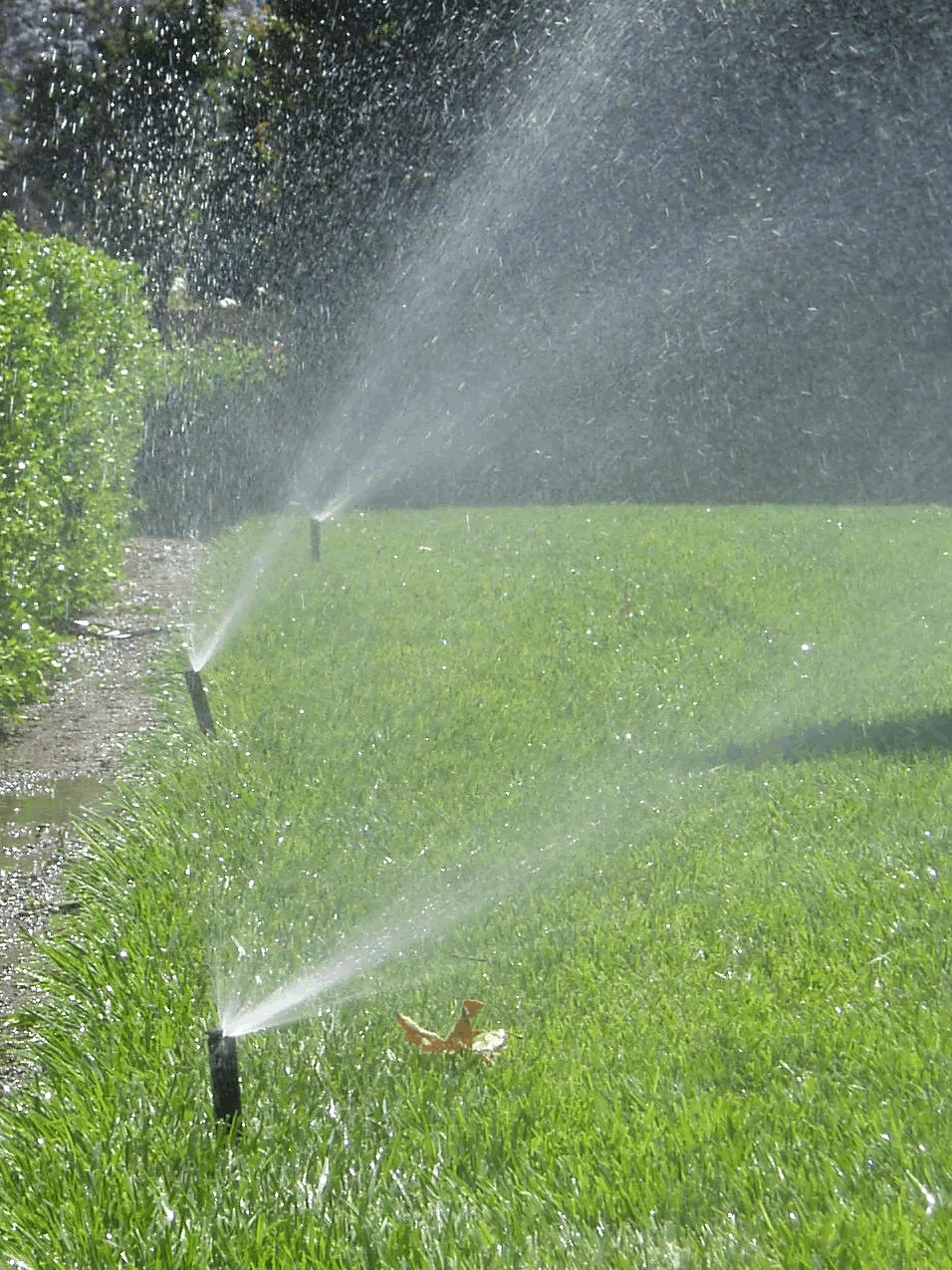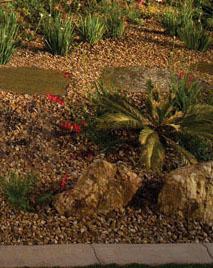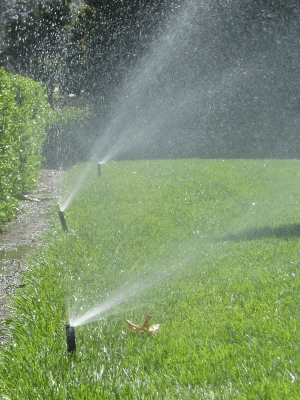Scope
The EPA WaterSense Home Specification does not have mandatory outdoor requirements. However, if installed, these systems may contribute to the mandatory 30% efficiency requirement. Refer to the specific WaterSense Approved Certification Method (WACM) for specific requirements.
The following are recommendations and best practices:
Minimize and right size irrigation for water efficiency.
- Use pop-up sprinklers for turfgrass.
- Use micro-irrigation system to water plants other than turfgrass.
Sprinkler irrigation refers to types of irrigation that use mechanical devices with nozzles (sprinklers) to distribute the water by converting water pressure to a high-velocity discharge stream or streams.
The U.S. Environmental Protection Agency WaterSense program recommends that sprinkler heads have a 4-inch or greater pop-up height and matched precipitation nozzles. Sprinkler irrigation shall not be used on strips of turfgrass less than 4 feet wide, nor on slopes in excess of 4 feet of horizontal run per 1 foot vertical rise (4:1). Ensure narrow strips of turfgrass (installed less than 4 feet wide) and steep slopes have micro-irrigation if they are irrigated.
See the Compliance Tab for links to related codes and standards and voluntary federal energy-efficiency program requirements.
Description
There are different types of landscaping irrigation equipment. Sprinkler irrigation is best suited for watering turfgrass as it can be designed to distribute water evenly over uniformly planted areas of turfgrass.

The varied heights of shrubs, trees, and plant beds can obstruct spray from sprinkler heads. Shrubs, trees, plant beds, and any other non-turf landscape can be watered most effectively using micro-irrigation. Micro-irrigation supplies water directly to plant roots, reducing overspray and runoff. Micro-irrigation works through the frequent application of small quantities of water on or below the soil surface as drops, tiny streams, or miniature spray through emitters or applicators placed along a water delivery line. Micro-irrigation encompasses a number of methods or concepts, such as bubbler, drip, trickle, mist, or spray and subsurface irrigation.
The EPA WaterSense specification recommends that micro-irrigation includes emission devices that have flow rates less than 30 gallons per hour (113.6 liters per hour). WaterSense specifies that sprinkler heads should have a 4-inch or greater pop-up height, as they need a certain amount of clearance above the turfgrass to operate correctly. Taller risers are less likely to be blocked by growing grass between mowings.
Designing a system with matched precipitation nozzles is an important water efficiency concept. A sprinkler head’s precipitation rate is the speed at which water is applied to a specific area. When an installer designs an irrigation system for a landscape, sprinkler heads are installed to deliver enough water to cover the entire area of the landscape. When all of the sprinkler heads within the zone or system have the same (or very similar) precipitation rates, they are said to have “matched precipitation.” Designing a system with matched precipitation-rate heads or nozzles can save water by ensuring that all areas of the landscape are watered at the same rate. This is especially important when a landscape has sprinklers with varying coverage (for example, half-arc and quarter-arc sprinklers).
Sprinkler irrigation should not be used on strips less than 4 feet wide, because it is difficult to irrigate narrow strips efficiently without creating overspray. Sprinkler irrigation should not be installed on slopes in excess of 4 feet of horizontal run per 1 foot vertical rise (4:1) because the flow rates associated with sprinklers are often a source of runoff on steep slopes.
An irrigation system installer can match the precipitation rate of the sprinkler heads in the irrigation system by calculating the precipitation rates and manually pairing similar heads in the same zone. The installer can also ensure matched precipitation by installing nozzles throughout the zone from the same family of nozzles produced by the same manufacturer. For matched precipitation, sprinkler head spacing must be consistent, flow rates must be based on coverage, and the pipes need to deliver water at a uniform pressure to each head.
Success
The EPA WaterSense Home Specification does not have mandatory outdoor requirements. However, if installed, these systems may contribute to the mandatory 30% efficiency requirement. Refer to the specific WaterSense Approved Certification Method (WACM) for specific requirements.
It is recommended that a certified irrigation professional verifiers that sprinkler irrigations systems comply with the criteria in the WACM. In addition, the certified irrigation professional will verify that the station or zone pressure based upon the emission device or product being used (spray head, rotor head) is within +/- 10% of manufacturer-recommended operating pressure. The certified irrigation professional will test this on a representative zone of the sprinkler irrigation system.
Climate
Minimize irrigation needs by designing climate-appropriate landscaping and selecting native and drought-tolerant plant species. Schedule watering to match local climate conditions. For example, irrigation watering is not typically needed in most U.S. climates in the fall, winter, and spring.
Training
Retrofit
The measures described in this guide apply to both new and existing homes.
More
More Info.
Access to some references may require purchase from the publisher. While we continually update our database, links may have changed since posting. Please contact our webmaster if you find broken links.
The following authors and organizations contributed to the content in this Guide.
Sales
Efficient Landscape Design = Water Saving Landscape Design

Landscaping irrigation needs can be reduced or even eliminated by choosing native, drought-tolerant species that can survive on available rainfall and by installing non-plant ground covers like rock and bark. If there will be plants that require irrigation, they can be planted in clusters for efficient irrigation, while the remainder of the yard receives little or no irrigation.
Efficient Landscape Irrigation =
EPA’s WaterSense program certifies weather-based irrigation controllers, which employ a "smart" irrigation control technology. These systems use local weather data to determine when and how much to water. Drip irrigation systems use 20% to 50% less water than conventional pop-up sprinkler systems and can save up to 30,000 gallons per year by delivering low volumes of water directly to the plant's' roots, minimizing losses to wind, runoff, evaporation, or overspray. Other technologies for reducing water use include control technologies that measure the moisture in the soil and tailor the irrigation schedule accordingly, rain sensors and rainfall shut-off devices that turn off irrigation on rainy days, and rotary spray sprinkler heads that lose less water to evaporation than misters.

